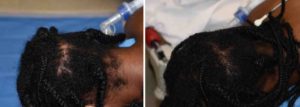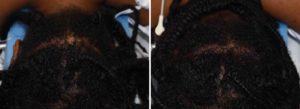Background: The back of the head, known as the occiput, has many attachments and features as it encircles the foramen magnum inferiorly and ascends superiorly to become more visible. At its more superior basilar part there has numerous horizontal bony lines which represent attachments of ligaments and muscles. In the middle of these bony lines sits the occipital knob.
While normally fairly flat it can develop more prominently and create the ‘occipital bun’ which is a prominent midline protrusion on the back of the head. While historically associated with the Neanderthal skull, it is less commonly seen today. All of the occipital knobs or buns that I have seen and treated have all been in men. Whether this means it is an exclusively male trait by genetics or is more visible in short hair or on a shaved head is unclear.
Case Study: This young petite female presented with a prominent knob on the back of her head. On examination there were also raised nuchal ridges running from the sides of the knob out to the sides of the skull. Even though she had long braided hair it was still a major aesthetic concern for her.

This is the first female I have seen with an occipital knob skull deformity. She had a very small and narrow skull but with a prominent bump on the back…proving it does not just occur in men.
Case Highlights:
1) Occipital knob skull deformities are most commonly seen in men and rarely in women.
2) Some occipital knobs can also have an associated elevated nuchal ridge.
3) The grid technique is a good method to ensure a smooth and even occipital knob skull reduction.
Dr. Barry Eppley
Indianapolis, Indiana





